The Sandy Bridge Preview
by Anand Lal Shimpi on August 27, 2010 2:38 PM ESTSandy Bridge Integrated Graphics Performance
With Clarkdale/Arrandale, Intel improved integrated graphics by a large enough margin that I can honestly say we were impressed with what Intel had done. That being said, the performance of Intel's HD Graphics was honestly not enough. For years integrated graphics have been fast enough to run games like the Sims but not quick enough to play anything more taxing, at least not at reasonable quality settings. The 'dales made Intel competitive in the integrated graphics market, but they didn't change what we thought of integrated graphics.
Sandy Bridge could be different.
Architecturally, Sandy Bridge is a significant revision from what's internally referred to as Intel Gen graphics. While the past two generations of Intel integrated graphics have been a part of the Gen 5 series, Sandy brings the first Gen 6 graphics die to market. With a tremendous increase in IPC and a large L3 cache to partake in, Sandy Bridge's graphics is another significant move forward.
Is it enough to kill all discrete graphics? No. But it's good enough to really threaten the entry level discrete market. Take a look:
Batman: Arkham Asylum

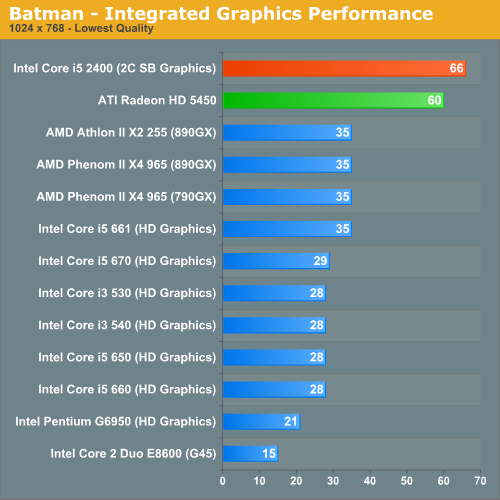
It's unclear whether or not graphics turbo was working on the part I was testing. If it was, this is the best it'll be for the 6 EU parts. If it wasn't, things will be even faster. Comparisons to current integrated graphics solutions are almost worthless. Sandy Bridge's graphics perform like a low end discrete part, not an integrated GPU. In this case, we're about 10% faster than a Radeon HD 5450.
Assuming Sandy Bridge retains the same HTPC features that Clarkdale has, I'm not sure there's a reason for these low end discrete GPUs anymore. At least not unless they get significantly faster.
Note that despite the early nature of the drivers, I didn't notice any rendering artifacts or image quality issues while testing Sandy Bridge's integrated graphics.
Dragon Age Origins
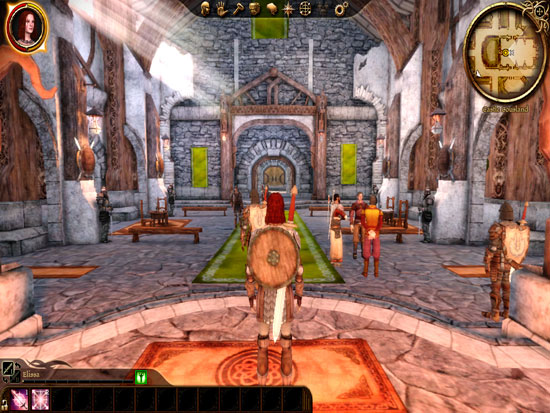
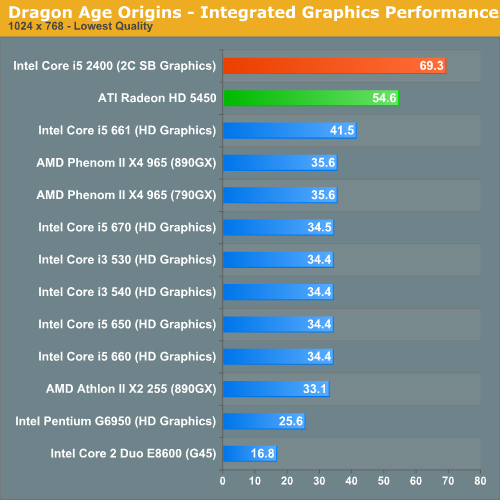
The Sandy Bridge advantage actually grows under Dragon Age. At these frame rates you can either enjoy smoother gameplay or actually up the resolution/quality settings to bring it back down to ~30 fps.
Dawn of War II
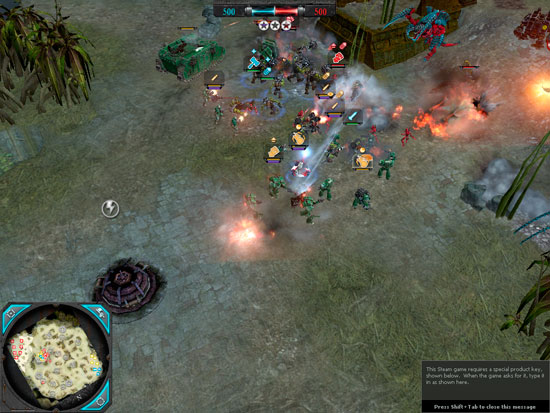
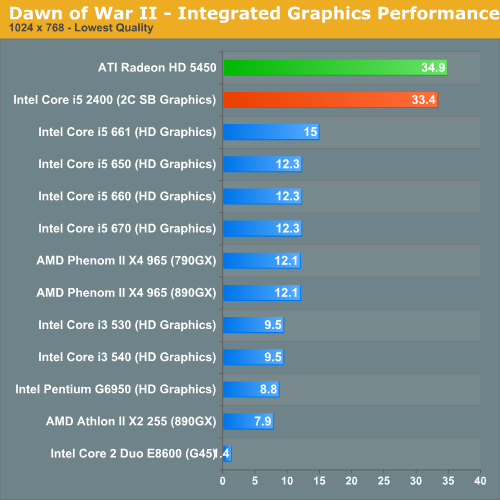
It's not always a clear victory for Sandy Bridge. In our Dawn of War II test the 5450 pulls ahead, although by only a small margin.
Call of Duty Modern Warfare 2
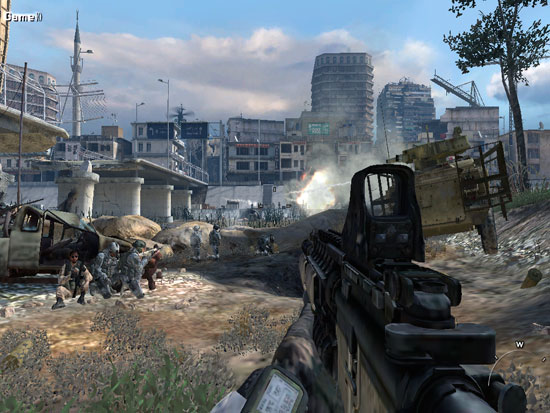
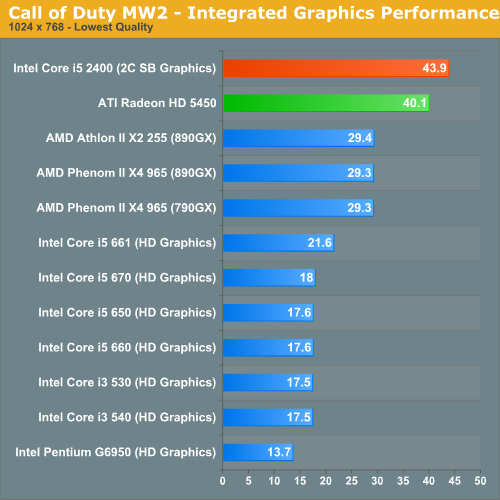
Sandy is one again on top of the 5450 in Modern Warfare 2. Although I'm not sure these frame rates are high enough to really up quality settings any more, they are at least smooth - which is more than I can say for the first gen HD Graphics.
BioShock 2
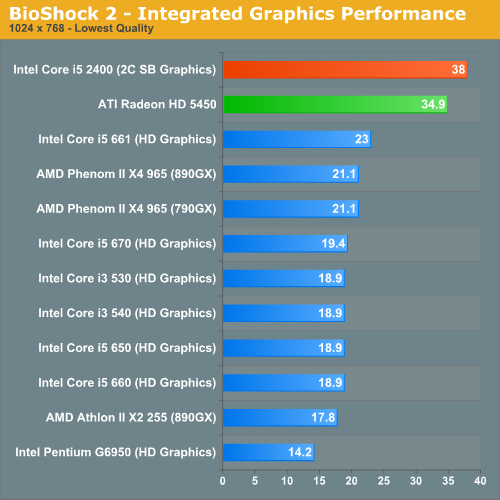
Intel promised to deliver a 2x improvement in integrated graphics performance with Sandy Bridge. We're getting a bit more than that here in BioShock 2.
World of Warcraft
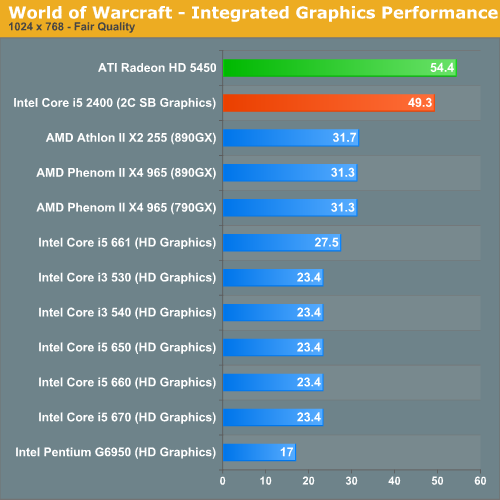
World of Warcraft is finally playable with Intel's Sandy Bridge graphics. The Radeon HD 5450 is 10% faster here.
HAWX
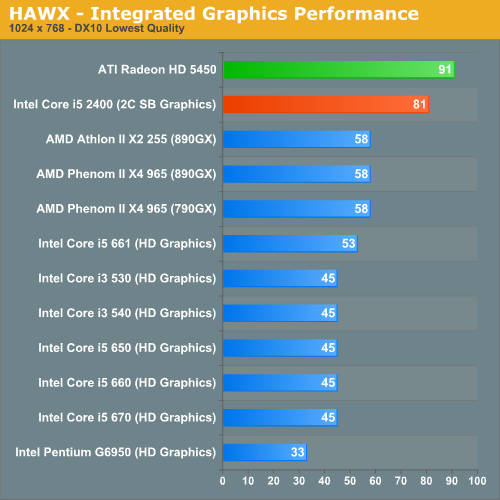
Sandy Bridge Graphics Performance Summary
This is still a very early look. Drivers and hardware both aren't final, but the initial results are very promising. Sandy Bridge puts all current integrated graphics solutions to shame, and even looks to nip at the heels of low end discrete GPUs. For HTPC users, Clarkdale did a good enough job - but for light gaming there wasn't enough horsepower under the hood. With Sandy Bridge you can actually play modern titles, albeit at low quality settings.
If this is the low end of what to expect, I'm not sure we'll need more than integrated graphics for non-gaming specific notebooks. Update: It looks like all notebook Sandy Bridge parts, at least initially, will use the 12 EU IGPs. Our SB sample may also have been a 12 EU part, we're still awaiting confirmation.










200 Comments
View All Comments
AndreC - Saturday, August 28, 2010 - link
Hi there.. I`m currently a freelance 3D generalist.. and I was going to upgrade my old Core 2 Quad QX6700 with a Core i7 980X. But now i`m not that confident. Sandy bridge looks amazing, I was sad seeing the new socket for sandy bridge, it does not compell me to buy a new motherboard now... does anyone know if the 1366 socket will stick with the nex gen High end market? I dont want to shoot myself in the foot here.AndreC - Saturday, August 28, 2010 - link
Sorry dind`t read the last frase...Great Review btw. cheers
sdsdv10 - Saturday, August 28, 2010 - link
As noted in the Intel roadmap in the article, for at least part of 2011 they will be sticking with 1366 for the release of the Core i7 990X (to replace the 980X). However, after that the Intel performance platform will switch over to socket LGA-2011. Here is a quote from the articlea (page 3)."Original Nehalem and Gulftown owners have their own socket replacement to look forward to. In the second half of 2011 Intel will replace LGA-1366 with LGA-2011. LGA-2011 adds support for four DDR3 memory channels and the first 6+ core Sandy Bridge processors."
AndreC - Saturday, August 28, 2010 - link
Yeah.. as I said "Sorry dind`t read the last frase..." but thx anyway..It`s a shame to be always changing sockets, but probabily a necessity to evolve the technology.
Kaihekoa - Saturday, August 28, 2010 - link
Having the first chips target the mainstream market is a very smart move by Intel because that's where AMD makes it's money. I'm honestly not impressed by the performance numbers, but I am impressed by the overall performance, power consumption, and pricepoints for these next gen CPUs. What I'm really looking forward to is the performance segment of Sandy Bridge.mino - Saturday, August 28, 2010 - link
Intel's mainstream is not where AMD's is.Especially in 2011.
Ontario:
. . . CPU - above Atom, under everything else
. . . GPU - 5450/Sandy class
Lliano:
. . . CPU - 2C Sandy class
. . . GPU - 5650 class (at least 3x Sandy)
Bulldozer Desktop(8C):
. . . CPU - 4C Sandy Class
. . . GPU - discrete 5750+ class
So basically AMD's platform in the Intel's "mainstream" $200+ class will be a Bulldozer with discrete GPU. Aka AMD's high end stuff.
silverblue - Saturday, August 28, 2010 - link
Not sure I agree with that. From AMD's own figures, Bulldozer is significantly faster than STARS. It would be more realistic to expect Bulldozer to perform closely to Sandy Bridge, however we really need more benchmarks before we get a true idea. Bulldozer looks great on paper, but that's virtually all we have so far.In any case, you compared Bulldozer to "4C Sandy Class", which would be an 8-thread Sandy Bridge, and thus - at least relatively - high end. And I'm not getting into the core/module argument again... ;)
mino - Sunday, August 29, 2010 - link
What I wanted to point out is that Intel sees the 4C Sandy as a "mainstream" part.Reason being they are moving HUGE amounts (compared to AMD) of $150-$250 parts.
On the other hand, AMD sees the mainstream at $100-$200 and that is a Llano market.
For AMD, Zambezi is high-end that justifies discrete GPU.
And Yes, Bulldozer 8C should compare with 4C Sandy favorably, (it would mostly go to pricing).
tatertot - Sunday, August 29, 2010 - link
BD 8C is going to be up against 8C and 6C Sandy on LGA-2011 in the client space.mino - Monday, August 30, 2010 - link
am sure AMD WOULD like it that way. But no. Not really.8C Bulldozer versus 6C Sandy might actually be competitive.
However 32nm SOI is a new process so we might as well forget about 4GHz parts for now.
Also, Sandy 6C is Q4 part and 8C is most probably 2012 part.